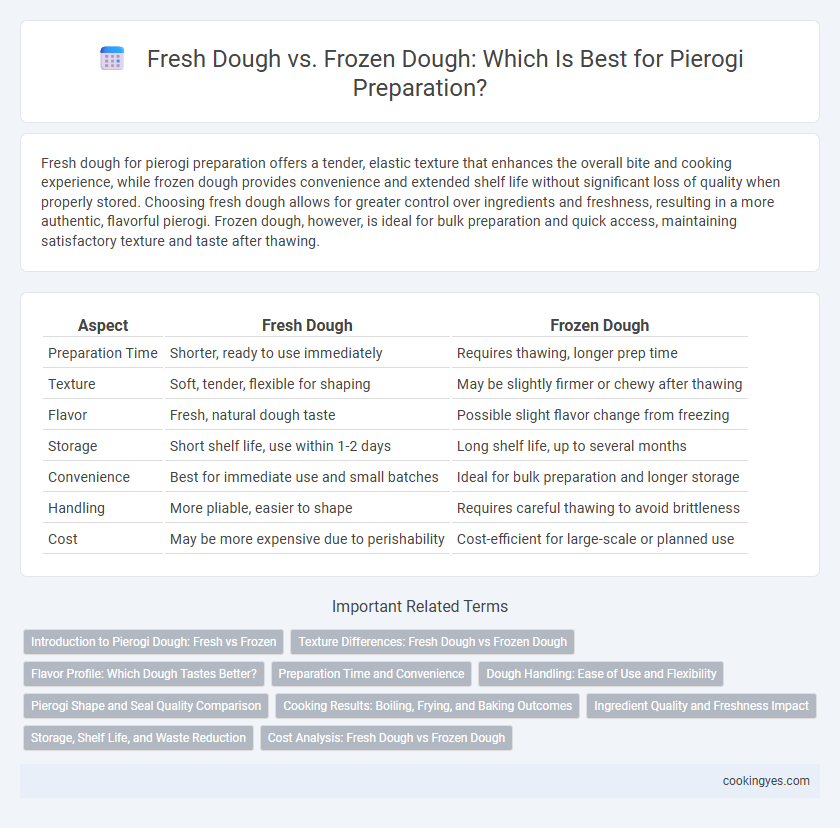Fresh dough for pierogi preparation offers a tender, elastic texture that enhances the overall bite and cooking experience, while frozen dough provides convenience and extended shelf life without significant loss of quality when properly stored. Choosing fresh dough allows for greater control over ingredients and freshness, resulting in a more authentic, flavorful pierogi. Frozen dough, however, is ideal for bulk preparation and quick access, maintaining satisfactory texture and taste after thawing.
Table of Comparison
| Aspect | Fresh Dough | Frozen Dough |
|---|---|---|
| Preparation Time | Shorter, ready to use immediately | Requires thawing, longer prep time |
| Texture | Soft, tender, flexible for shaping | May be slightly firmer or chewy after thawing |
| Flavor | Fresh, natural dough taste | Possible slight flavor change from freezing |
| Storage | Short shelf life, use within 1-2 days | Long shelf life, up to several months |
| Convenience | Best for immediate use and small batches | Ideal for bulk preparation and longer storage |
| Handling | More pliable, easier to shape | Requires careful thawing to avoid brittleness |
| Cost | May be more expensive due to perishability | Cost-efficient for large-scale or planned use |
Introduction to Pierogi Dough: Fresh vs Frozen
Fresh dough for pierogi offers a tender texture and more pliability, allowing for easier shaping and sealing, which enhances the overall eating experience. Frozen dough serves as a convenient alternative, preserving the dough's freshness and extending its shelf life without compromising the classic pierogi taste. Using fresh dough typically results in a softer, more delicate pierogi, while frozen dough provides consistent quality and time-saving benefits for home cooks and restaurants.
Texture Differences: Fresh Dough vs Frozen Dough
Fresh dough for pierogi yields a tender, pliable texture that cooks evenly, enhancing the dumpling's delicate chew. Frozen dough often becomes denser and may develop small ice crystals that disrupt the smooth consistency, resulting in a firmer bite after cooking. Texture differences between fresh and frozen dough significantly impact the overall mouthfeel and authenticity of homemade pierogi.
Flavor Profile: Which Dough Tastes Better?
Fresh dough for pierogi offers a tender, delicate texture that enhances the natural flavors of fillings like potato, cheese, or sauerkraut, providing a superior taste experience compared to frozen dough. Frozen dough tends to lose elasticity and moisture during storage, resulting in a denser, less flavorful crust that can diminish the overall dish quality. The flavor profile of pierogi is markedly improved when fresh dough is used, as it absorbs fillings better and yields a more authentic, homemade taste.
Preparation Time and Convenience
Fresh dough for pierogi preparation offers a softer texture and can be rolled out immediately, reducing overall preparation time, ideal for same-day cooking. Frozen dough, while requiring thawing and slight softening, provides convenience for batch preparation and storage, enabling quick access for future meals. Choosing between fresh and frozen dough depends on balancing immediate freshness with long-term time-saving benefits in pierogi making.
Dough Handling: Ease of Use and Flexibility
Fresh dough for pierogi offers superior elasticity and softness, making it easier to roll out and shape with precise thickness control. Frozen dough often requires thawing, which can reduce flexibility and increase the risk of tearing during handling. Choosing fresh dough enhances the dough's malleability, enabling smoother folding and sealing for consistent pierogi quality.
Pierogi Shape and Seal Quality Comparison
Fresh dough for pierogi offers superior elasticity and moisture content, resulting in easier shaping and a more consistent, tight seal that prevents filling leakage during boiling or frying. Frozen dough tends to become slightly more brittle and less pliable after thawing, which can lead to imperfect edges and weaker seals, increasing the risk of pierogi bursting. Maintaining optimal dough hydration and temperature is crucial for achieving a uniform crescent shape and a durable, well-pressed seam.
Cooking Results: Boiling, Frying, and Baking Outcomes
Fresh dough for pierogi offers a tender texture and quicker cooking times, resulting in a delicate, pillowy bite after boiling. Frozen dough tends to retain firmness during frying, creating a crispier exterior and enhanced contrast with the filling. Baking pierogi with fresh dough yields a soft crust, while frozen dough produces a slightly chewier crust with more structural integrity.
Ingredient Quality and Freshness Impact
Fresh dough for pierogi preparation maintains higher ingredient quality and freshness, resulting in a tender texture and superior flavor profile due to its immediate use after mixing. Frozen dough, while convenient, may experience slight degradation in gluten structure and moisture balance, potentially affecting the dough's elasticity and overall consistency once thawed. Selecting fresh dough ensures optimal freshness and ingredient integrity, enhancing the traditional pierogi experience with a delicate bite and authentic taste.
Storage, Shelf Life, and Waste Reduction
Fresh dough for pierogi offers superior texture and flavor but requires immediate use within 1-2 days when stored in the refrigerator to prevent spoilage, making it less ideal for long-term storage. Frozen dough extends shelf life significantly, typically lasting up to 3-6 months in the freezer while maintaining quality when properly sealed, reducing waste by allowing portion control and extended planning. Choosing frozen dough helps minimize food waste and supports more efficient storage management in both home and commercial kitchens.
Cost Analysis: Fresh Dough vs Frozen Dough
Fresh dough for pierogi preparation often incurs higher upfront costs due to labor and ingredient freshness requirements, but it can yield superior texture and flavor that may justify the investment for artisan producers. Frozen dough offers cost savings through bulk production and extended shelf life, reducing waste and labor expenses, which benefits high-volume operations seeking efficiency. Evaluating the total cost must consider product quality, storage capabilities, and production scale to determine the most economical option for pierogi makers.
Fresh Dough vs Frozen Dough for Pierogi Preparation Infographic

 cookingyes.com
cookingyes.com